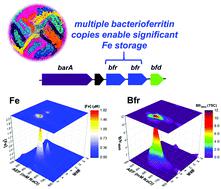当前位置:
X-MOL 学术
›
Metallomics
›
论文详情
Our official English website, www.x-mol.net, welcomes your feedback! (Note: you will need to create a separate account there.)
Characterization of the Fe metalloproteome of a ubiquitous marine heterotroph, Pseudoalteromonas (BB2-AT2): multiple bacterioferritin copies enable significant Fe storage.
Metallomics ( IF 3.4 ) Pub Date : 2020-04-15 , DOI: 10.1039/d0mt00034e Michael G Mazzotta 1 , Matthew R McIlvin , Mak A Saito
Metallomics ( IF 3.4 ) Pub Date : 2020-04-15 , DOI: 10.1039/d0mt00034e Michael G Mazzotta 1 , Matthew R McIlvin , Mak A Saito
Affiliation

|
Fe is a critical nutrient to the marine biological pump, which is the process that exports photosynthetically fixed carbon in the upper ocean to the deep ocean. Fe limitation controls photosynthetic activity in major regions of the oceans, and the subsequent degradation of exported photosynthetic material is facilitated particularly by marine heterotrophic bacteria. Despite their importance in the carbon cycle and the scarcity of Fe in seawater, the Fe requirements, storage and cytosolic utilization of these marine heterotrophs has been less studied. Here, we characterized the Fe metallome of Pseudoalteromonas (BB2-AT2). We found that with two copies of bacterioferritin (Bfr), Pseudoalteromonas possesses substantial capacity for luxury uptake of Fe. Fe : C in the whole cell metallome was estimated (assuming C : P stoichiometry ∼51 : 1) to be between ∼83 μmol : mol Fe : C, ∼11 fold higher than prior marine bacteria surveys. Under these replete conditions, other major cytosolic Fe-associated proteins were observed including superoxide dismutase (SodA; with other metal SOD isoforms absent under Fe replete conditions) and catalase (KatG) involved in reactive oxygen stress mitigation and aconitase (AcnB), succinate dehydrogenase (FrdB) and cytochromes (QcrA and Cyt1) involved in respiration. With the aid of singular value decomposition (SVD), we were able to computationally attribute peaks within the metallome to specific metalloprotein contributors. A putative Fe complex TonB transporter associated with the closely related Alteromonas bacterium was found to be abundant within the Pacific Ocean mesopelagic environment. Despite the extreme scarcity of Fe in seawater, the marine heterotroph Pseudoalteromonas has expansive Fe storage capacity and utilization strategies, implying that within detritus and sinking particles environments, there is significant opportunity for Fe acquisition. Together these results imply an evolved dedication of marine Pseudoalteromonas to maintaining an Fe metalloproteome, likely due to its dependence on Fe-based respiratory metabolism.
中文翻译:

普遍存在的海洋异养菌,假性铝单胞菌(BB2-AT2)的铁金属蛋白质组的表征:多种细菌铁蛋白的复制可实现大量的铁存储。
铁是海洋生物泵的关键养分,该过程是将上层海洋中光合固定碳输出到深海的过程。铁的限制控制着海洋主要区域的光合作用活动,特别是海洋异养细菌促进了出口光合材料的后续降解。尽管它们在碳循环中很重要并且海水中Fe的稀缺性,但对这些海洋异养生物的Fe需求,储存和胞质利用的研究却很少。在这里,我们表征了假单胞菌(BB2-AT2)的铁金属化。我们发现假单胞菌具有两个拷贝的细菌铁蛋白(Bfr),具有大量吸收铁的能力。估算了整个细胞金属网中的Fe:C(假设C:P化学计量为〜51:1)介于约83μmol:mol Fe:C之间,比以前的海洋细菌调查高约11倍。在这些充足的条件下,观察到其他主要的胞质铁相关蛋白,包括超氧化物歧化酶(SodA;在富铁条件下不存在其他金属SOD同工型)和过氧化氢酶(KatG),它们参与了活性氧胁迫的缓解和乌头酸酶(AcnB),琥珀酸脱氢酶(FrdB)和细胞色素(QcrA和Cyt1)参与呼吸。借助奇异值分解(SVD),我们能够计算出金属分子内的峰归因于特定的金属蛋白贡献者。一个推定的铁络合物TonB转运蛋白与密切相关的Alteromonas细菌相关联,在太平洋近中生环境中含量丰富。尽管海水中铁极度匮乏,海洋异养假单胞菌具有广泛的铁储存能力和利用策略,这表明在碎屑和沉没颗粒环境中,铁的获得机会很大。这些结果共同暗示着海洋假单胞菌致力于维持铁金属蛋白质组的发展,这可能是由于其依赖于基于铁的呼吸代谢。
更新日期:2020-04-15
中文翻译:

普遍存在的海洋异养菌,假性铝单胞菌(BB2-AT2)的铁金属蛋白质组的表征:多种细菌铁蛋白的复制可实现大量的铁存储。
铁是海洋生物泵的关键养分,该过程是将上层海洋中光合固定碳输出到深海的过程。铁的限制控制着海洋主要区域的光合作用活动,特别是海洋异养细菌促进了出口光合材料的后续降解。尽管它们在碳循环中很重要并且海水中Fe的稀缺性,但对这些海洋异养生物的Fe需求,储存和胞质利用的研究却很少。在这里,我们表征了假单胞菌(BB2-AT2)的铁金属化。我们发现假单胞菌具有两个拷贝的细菌铁蛋白(Bfr),具有大量吸收铁的能力。估算了整个细胞金属网中的Fe:C(假设C:P化学计量为〜51:1)介于约83μmol:mol Fe:C之间,比以前的海洋细菌调查高约11倍。在这些充足的条件下,观察到其他主要的胞质铁相关蛋白,包括超氧化物歧化酶(SodA;在富铁条件下不存在其他金属SOD同工型)和过氧化氢酶(KatG),它们参与了活性氧胁迫的缓解和乌头酸酶(AcnB),琥珀酸脱氢酶(FrdB)和细胞色素(QcrA和Cyt1)参与呼吸。借助奇异值分解(SVD),我们能够计算出金属分子内的峰归因于特定的金属蛋白贡献者。一个推定的铁络合物TonB转运蛋白与密切相关的Alteromonas细菌相关联,在太平洋近中生环境中含量丰富。尽管海水中铁极度匮乏,海洋异养假单胞菌具有广泛的铁储存能力和利用策略,这表明在碎屑和沉没颗粒环境中,铁的获得机会很大。这些结果共同暗示着海洋假单胞菌致力于维持铁金属蛋白质组的发展,这可能是由于其依赖于基于铁的呼吸代谢。


























 京公网安备 11010802027423号
京公网安备 11010802027423号